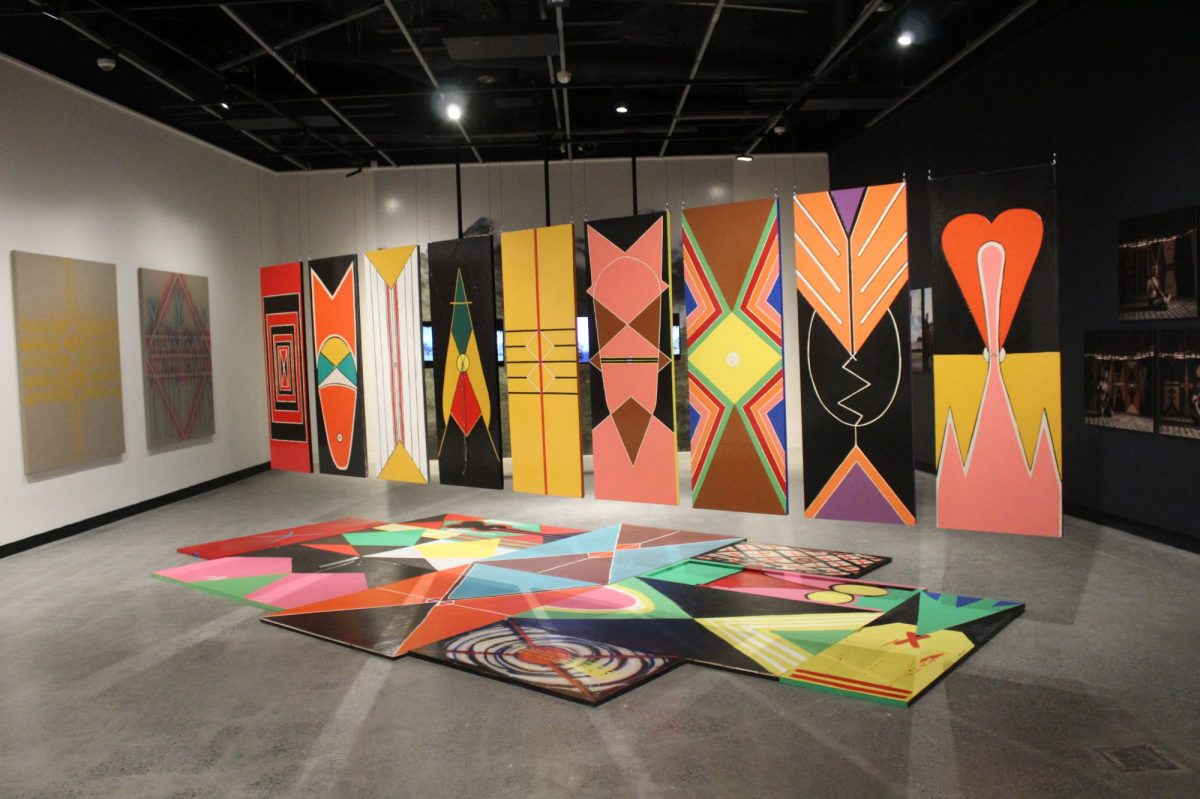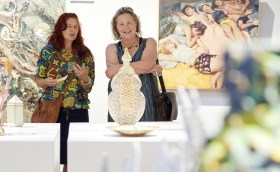yubilong(mi)bilongyu at Griffith University Art Museum (GUAM) charts the meteoric ascent of alumnus Yuriyal Bridgeman. The exhibition opened its doors a week shy of the 11th Asia Pacific Triennial of Contemporary Art (APT11) up the road at the Queensland Art Gallery | Gallery of Modern Art (QAGAOMA). This iteration features Haus Yuriyal, a collective the Redcliffe-born Yuri Alaiku artist co-founded in his ancestral home province of Simbu in Papua New Guinea.
Bridgeman and frequenters of his ‘haus’ have proved scintillating in past showcases from Primavera in 2011 to the 23rd Sydney Biennale in 2022. yubilong(mi)bilongyu serves to demonstrate both the breadth of his multidisciplinary practice and deep significance of his contribution to the post-colonial Australian landscape.
How long is a decade and a half in artist years? The progress Bridgeman has achieved since graduating in 2008 should be apparent to viewers upon entering the main gallery space. On the left are three artworks from The Sport and Fair Play of Aussie Rules (2008-10) series. Through their campness, the self-portraits critique stereotypes from black ‘Wilma Jr’ to white ‘Boi Boi the Labourer’.
Notably, the latter reflects the profession of Bridgeman’s father. Racial prejudices are examined through his embrace of ‘black-face’ and ‘white-face’. To the immediate right stands a fibreglass rendition of ‘Wilma’ who has, over the course of 14 years, evolved into the headgear-clad protagonist of Darren and his Lewa (2024). The instinctual response – at least for this writer – is to join the figure in its gaze of an unprimed linen canvas bearing football jersey markings. ‘Lewa’ means ‘one’s heart’ in Tok Pisin. Has Bridgeman come full circle?
Astute readers may have noted the inconsistency between the title of the aforementioned series and the subject matter. Bridgeman does play with many codes in his practice. However, ‘rules’ may allude to the Australian governance of Papua prior to 1973. Is he drawn to Australian Rugby League for the prospects of fairness and clearly defined boundaries?
Over the past decade, the artist has established himself as a force to be reckoned with – and a genre of his own defining: shield painting. A pivotal installation, Scrum (2019), which was first exhibited at The National 4, is positioned on the floor. Although the artwork incorporates ‘elements’ of ‘rugby league design’, primarily referenced are ‘Kuman’ or the coloured shields of Bridgeman’s ancestors. Several more recent and individually titled shield paintings are suspended above. Providing 360 degrees of vantage immerses viewers and alludes to the original function of the forms.
The three-HD screen video installation The Fight (2010-20) exposits the equivalence between the two sources of his vibrant patterns. Juxtaposed is a rugby game and a re-enactment of a battle. In the latter, distinctive Kuman provide a means of identifying sides. Kaupa, Kondi Kanem country (2017) is among a triptych of photographs immersing the shield paintings in the countries of their co-creators. Likewise, Mondo Munum, Yuriyal Hausman (2024) is one of a quintuplet of photographic portraits depicting the shield paintings with the people they represent. Emphasised is the ethnographic value of Bridgeman’s work in documenting the visual language of Papua New Guinean tribes.
The most fun of the compositions revisited in this spectacular survey could be the former centrepiece of the Home of the Arts (HOTA) A barrow, a singing: The Premiers (2022) – albeit in an abridged form to fit the space. On this occasion, the semblance of markings on a football field appear folded across two walls of the gallery. Animalistic in orientation, painted pink wheelbarrows are piled up in this corner. A latitude for interpretation is afforded to the viewer. The high key pink and green, reminiscent of children’s toys, could belie political intent. After all, barrows move dirt.
This exposition of the exponential growth of a graduate demonstrates the worth of art museums operating within educational institutions. Gallery-goers are likely to have been beguiled by aspects of Bridgeman’s practice in the past. Each artwork is vibrant, insightful and salient. But his consistent application of paint, beginning with ‘white-face’, needs to be noticed across several series. A progression from the body as a site for identity manifestation and manipulation, to apparel and accessories, can also be observed. Most importantly, the ethnographic value of the objects is impressed upon viewers by depicting them in use.
Read: Exhibition review: The Limits of My Language Are the Limits of My World, Gertude Glasshouse
Visiting yubilong(mi)bilongyuI is likely to enhance the viewing experience of Haus Yuriyal at APT11. Nonetheless, this playful and provocative solo presentation requires no accompaniment.
Yuriyal Bridgeman: yubilong(mi)bilongyu
Griffith University Art Museum
The exhibition runs until 15 March 2025.





